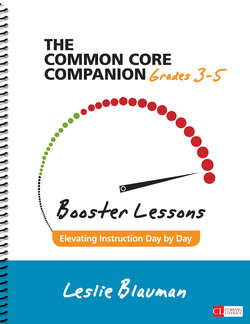Читать книгу The Common Core Companion: Booster Lessons, Grades 3-5 - Leslie Blauman - Страница 11
На сайте Литреса книга снята с продажи.
Think Peer Models and Peer Collaboration
ОглавлениеToward the end of each sequence, you’ll see I included writing samples from students and also have a page called “Peer Power: How to Use Student Work as Mentor Texts.” Integrating students’ writing into the weave of your reading and writing instruction is as important as integrating standards. Let me repeat that: it’s as important as integrating standards. Student writing as mentor texts functions like the Panama Canal, connecting the Atlantic and Pacific Oceans. When kids read and discuss each other’s work, suddenly the “continents” of reading and writing connect, the passageway is clear! The purpose of reading and the purpose of writing suddenly matter because the writer is right there to embody the ideas, answer questions, clarify. And in the push for authentically student-driven dialogue, it makes such sense to use student pieces because students can more naturally pose and pursue the questions when they or peers “own” the texts at the heart of the discourse.
So as you embark on teaching with these sequences, I encourage you to begin to build a bank of student work and use it. Often. Used in combination with the work of published writers, it’s powerful.
Students’ written work is also, of course, the data to look at in order to figure out what you might want to teach next. The pages of student work are called “What Do I See?” to encourage that kind of daily and weekly assessment that the best teachers do. Spot the kids who need a small-group reteach; spot the child who needs one-on-one support. Spot the students who you suddenly see would work really well together on some aspect of reading and writing. This wise, informed “seeing” of kids’ written work (and verbal work for that matter) leads into the fourth and final facet of integration I want to point out—bringing an even greater degree of intention to integrating reading and writing.
